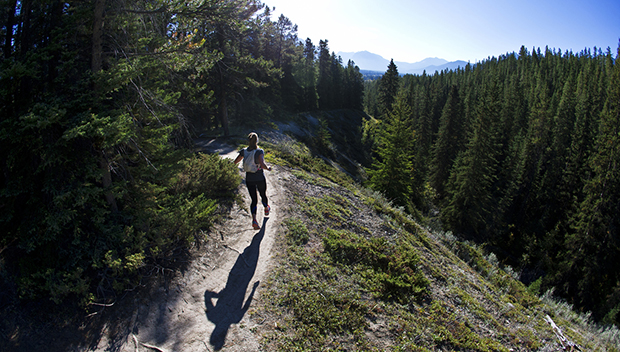
These days, trail running is more popular than ever, and it's easy to see why. Running over meadows and through the woods is the perfect way to escape the frenzy of daily life for an hour or two. Plus, it allows you to log more training miles with less strain on your joints. But many road runners don't realize that there's a lot more to trail running than just veering off the paved pathway. Depending on climate, distance and terrain, trail running can feel like a different sport altogether—one that requires its own gadgets, gear and training tips. Fortunately, we put together a trail running survival guide with everything you need to get started.
The Gear
The terrain can be extremely variable when trail running, even over the course of the same run, so you need to be prepared. For shorter runs over well-known terrain, all you need is a decent pair of trail shoes. As with road running, the most important feature in a trail shoe is fit. After that, you'll want to consider what kind of trails you'll be tackling. If your local trails have a lot of rocks and tree roots, you probably want a shoe with a more rigid sole. If you'll be crossing water frequently, your shoes should drain well and dry quickly. Fortunately, the shoe industry has kept up with the explosion of this niche market, so there almost as many different trail running shoes to choose from as there are types of terrain.
For longer trail runs, you'll want to bring along extra gear, including water and food or gels to keep you going, a whistle or other emergency signal and a mini first aid kit that has at a minimum gauze, athletic tape, a pressure-activated ice pack and antihistamine tablets for bug bites or stings. To carry all of this necessary gear, you can use a waist pack, a small backpack or hydration pack, or wear a pair of runner-specific cargo shorts and stash your goodies in the pockets.
If you'll be traversing steep, technical terrain, it's a good idea to run or power hike with trekking poles, which can help you keep your balance and lessen the impact on your joints by 25 percent. Finally, if your runs take you into remote, wild areas, it can't hurt to carry a snake bite kit and/or bear spray.
Training Tips
All of those steep climbs, tree roots and loose-gravel descents can put a runner in greater danger of falling or turning an ankle. To ensure injury-free runs through the forest, it's a good idea to supplement your running with some targeted cross-training.
For starters, add a few minutes of balance drills to your pre-run warm-up. Stand on one leg for 30 to 45 seconds, first on a flat, solid surface and then progressing to uneven or soft surfaces. Next, cue and strengthen your knee and hip stabilizers with side-to-side and bounding exercises, such as speed skaters, cross-over agility ladders and progressively bigger skipping strides.
After your runs—or in your downtime—improve ankle flexibility with stretches that promote greater plantar flexion (point your toes and gently pull the top of your foot to make it as flat as possible) and dorsiflexion (hang your heels off the back of a stair step and gently stretch the calf muscles and soleus). Finally, try and/or split squats, which will build the single leg strength necessary for steep climbs and descents.
Cool Tech for Navigating Your Trail Runs
You've got the gear and your body is ready to hit the trails, but how do you avoid getting lost? There was a time when you had to spend hundreds of dollars on a GPS to successfully navigate through the woods. These days you don't have to thanks to a growing number of cutting-edge apps for your smartphone.For starters, the compass app (or traditional compass) that is native to iPhones works reliably well and needs no Wi-Fi or cellular service to function. There are also a number of free apps for Android phones that work the same way. Use this whenever you come to a fork in the trail and aren't sure which way to go.
If you tend to need a little more direction than that, there are dozens of free or low-cost apps that provide both topographical and satellite trail maps and allow you to create routes, add waypoints and more. If you frequently run in areas where there is no Wi-Fi or cell service, most of these apps also allow you to download the maps before you head out into the wild. Just search for "topographical maps" or "trail maps" in your app store. And if you're planning a run through a National Park, REI has an app that offers all of these capabilities completely free of charge.
 READ THIS NEXT: Is Trail Running the New Marathon?
READ THIS NEXT: Is Trail Running the New Marathon?


